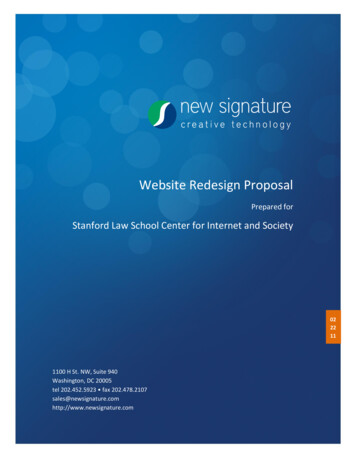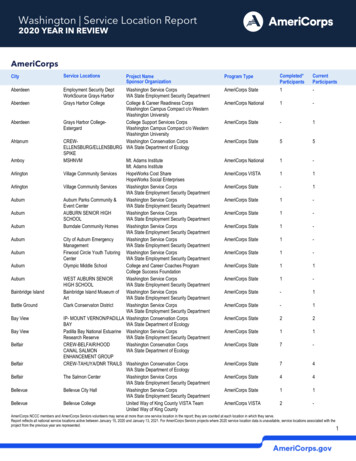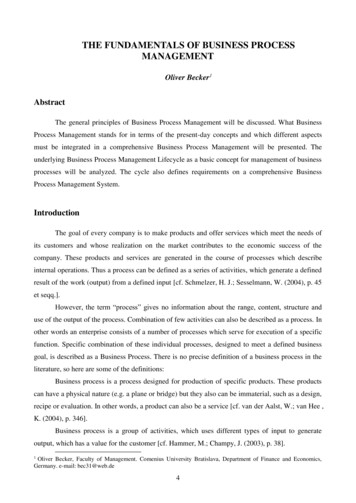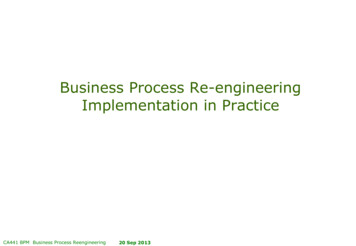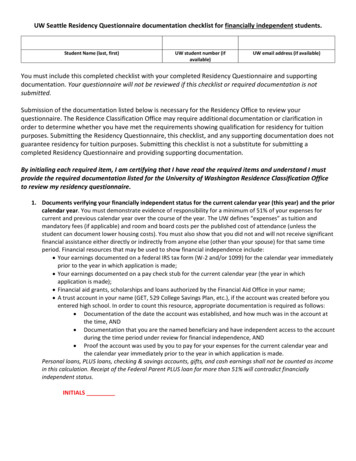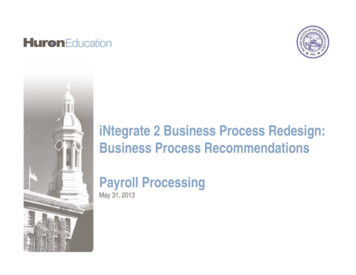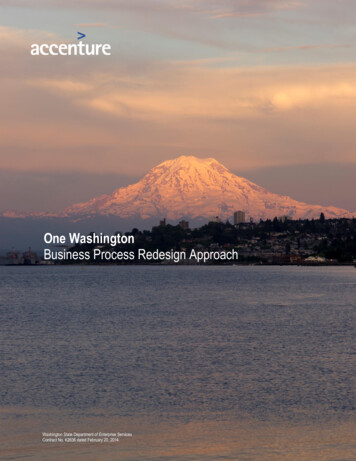
Transcription
One WashingtonBusiness Process Redesign ApproachWashington State Department of Enterprise ServicesContract No. K2636 dated February 20, 2014
One Washington Project DeliverableBusiness Process Redesign ApproachTable of Contents1.0Deliverable Overview. 31.1Purpose . 31.2Key Question . 31.3Key Considerations. 32.0Executive Summary. 43.0Introduction . 53.1Software-Agnostic Approach . 53.2Software-Driven Approach . 73.3Operating Principles . 83.4Integrating BPR with Lean . 94.0Approach to Business Process Redesign Segmentation . 104.1Innovation vs. Optimization vs. Standardization . 104.2Methodology for Prioritization . 114.3Results of prioritization . 125.0Recommended Path Forward . 145.1Prioritizing Business Processes for Redesign. 145.2Cross-Process Initiative . 162Washington State Department of Enterprise ServicesContract No. K2636 dated February 20, 2014
One Washington Project DeliverableBusiness Process Redesign Approach1.0 Deliverable Overview1.1 PurposeThe Business Process Redesign Approach provides One Washington leadership with a recommendedapproach for redesigning Finance, Procurement and Human Resource business processes in conjunctionwith an Enterprise Resource Planning (ERP) implementation. This deliverable establishes two “rounds” ofprocess redesign that the State can take, and recommends a path forward that best enables the State toimprove process performance in the short-term while keeping in mind a longer-term ERP implementation.This approach is based on insights developed through the Service Delivery Strategy and Business ProcessAssessment efforts.1.2 Key QuestionThe Business Process Redesign Approach will help State leadership make the following decision:For those Finance, Procurement, and HR business processes that require redesign ahead of anERP solution, what approach to redesign should the State take?1.3 Key ConsiderationsThis deliverable takes into consideration the following: Business process redesign is not required prior to ERP implementation, but is being considered asan opportunity to improve results, reduce risk, and expedite implementation after ERP software isselected. The recommended approach pertains to the same set of business process areas that wereincluded in the business process assessment. The role of Accenture is to recommend the business process redesign approach, and it is up to theState to decide whether to execute business process redesign activities in advance of an ERPimplementation. Should it choose to move forward, the State will also be responsible fordetermining the business process redesign methodologies to be used. The Business Process Redesign Approach deliverable builds upon the Service Delivery Strategyand Business Process Assessment to examine (i) which candidates for business process redesignpresent the largest potential for a positive impact on service delivery and (ii) which candidates forbusiness processes redesign are most feasible ahead of an ERP implementation. The Business Process Redesign Approach deliverable meets the requirement defined in ContractK2636 in the Compensation Section, as well as in the Statement of Work, Section 5.1, related toPhase 1, Deliverable #4.3Washington State Department of Enterprise ServicesContract No. K2636 dated February 20, 2014
One Washington Project DeliverableBusiness Process Redesign Approach2.0 Executive SummaryAs the State looks ahead to the potential value of an ERP implementation to replace its financial andprocurement systems, business process redesign provides an opportunity for the State to achieve greaterefficiency and effectiveness of processes in the near-term. Two approaches for business process redesignhave emerged within the ERP industry: one approach is to perform business process redesign (BPR)activities independent of the ERP software, what we refer to as a software-agnostic approach. The secondis to select the software and then conduct BPR activities to fill gaps not provided by the software, which wecall the software-driven approach.Recommendation: Based on our analysis, we recommend the State undertake two rounds of businessprocess redesign. The first round is a software-agnostic approach for a subset of business process areasthat focuses on innovating, optimizing, and standardizing business processes in the near-term. The secondround is a software-driven approach for the business process areas.In addition, we recommend several key cross-agency activities, including defining “payee” master data,defining “customer” master data, defining a uniform chart of accounts to be activated after ERP software isselected, creating a reporting strategy, and implementing a business process management capability.We recommend the business processes listed below be considered as candidates for inclusion in the firstround of BPR. Once this list of processes is confirmed, we recommend further analysis in Phase 2 to definea path forward for redesign. FinanceAccounts payableAccounts receivableGrants managementFinance analyticsPerformance planningProject accounting ProcurementStrategic sourcingInternal customer satisfactionInternal customer complaintProcure to pay strategySourcing and categoryplanningCategory managementVendor relationshipmanagement strategyImprovement and changestrategyProcurement datamanagementReceiptPO ProcessingHuman Resources Should be determinedfollowing a full assessment ofHR business processesA critical success factor for this approach is to examine agencies’ readiness for redesign activities ahead ofan ERP implementation. The subsequent readiness and change management analysis in Phase 2 caninform One Washington leadership’s decision on the timing of activities.4Washington State Department of Enterprise ServicesContract No. K2636 dated February 20, 2014
One Washington Project DeliverableBusiness Process Redesign Approach3.0 IntroductionIn recent years, two approaches for business process redesign have emerged within the ERP industry: oneapproach is to perform business process redesign (BPR) activities independent of the ERP software, whatwe refer to as a software-agnostic approach. The second is to select the software and then conduct BPRactivities to fill gaps not provided by the software, which we call the software-driven approach.For the One Washington project, we recommend both approaches. We believe the State can make manyadvances and improvements by doing certain BPR activities now, in anticipation of an eventual ERPsoftware selection. By starting with process redesign, the State has an opportunity to build recognition ofthe One Washington project as a business-driven transformation and ownership over the individualprocesses. We also believe the State should do a second round of BPR, after the software has beenselected. This dual approach allows the State to avoid spending effort redesigning processes that are likelyto be significantly impacted by the implementation of the ERP. Both approaches need to be grounded in acommon and agreed-upon understanding of the business process areas determined to be in-scope, andguided by a set of principles that anchors the activities in the overall vision for One escriptionA business driven approach starts byconnecting processes to theorganizational strategy. This allowsfor segmentation based on thepotential value of redesign.Processes are then treated differentlybased on their importance to theorganization.A “fit-gap” approach to redesigningbusiness processes for a softwareimplementation. Align theorganization’s processes to theselected software to reduceexpensive software customizationsand maximize the value of ERPsoftware.Pros Starts with priorities ofbusiness and focuseson business value Enables near termimprovements withoutwaiting for softwareCons Software selected mayrequire re-work Reduces softwarecustomizations BPR constrained tosoftware-modules inscope and by softwarecapabilities Need to select softwarebefore getting started3.1 Software-Agnostic ApproachThe software-agnostic approach starts by identifying the universe ofbusiness process areas that should be considered for redesign. For theOne Washington project, we have used Accenture’s Logical OperatingModels (LOMs) for Finance, Human Resources, and Procurement todefine and categorize the processes under consideration. Thesemodels group like processes into categories and visually depict theoverall structure of a given function (e.g., Finance). An example of theFinance LOM is included in Figure 1.Logical Operating Models provide the starting point for theprioritization of redesign efforts. The processes in the LOM can3-1 Finance Logical Operating Model5Washington State Department of Enterprise ServicesContract No. K2636 dated February 20, 2014
One Washington Project DeliverableBusiness Process Redesign Approachbe compared against a set of criteria to determine those processes for which the state would see thegreatest benefit from redesigning. For Washington, we recommend the state use three distinct criteria toevaluate and prioritize processes as candidates for round 1. Specifically: Current Process Performance: This is the degree of improvement suggested by the results of theBusiness Process Assessment. It is intended to capture the size of the “opportunity” that exists tobring the process up to leading practice. Current performance is outlined in the Business ProcessAssessment deliverable. Strategic Importance: Intended to capture the impact that the process has on service delivery inWashington. An initial perspective on strategic importance was developed by the participants of theStrategy Labs and updated based on feedback from the One Washington team. Dependency on New Technology: This is to filter out process areas where significantimprovements are not feasible without new technology or require significant redesign as part of atechnology implementation. In these cases, the amount of rework required is likely to exceed theshort term value gained from BPR. Processes with a heavy connection to technology are outlinedin Section 5.1.For business processes that have been prioritized for redesign, there are a standard set of activities thatcan be followed. The activities described below are often part of the process. In Section 4.1, werecommend that the state take different approaches to redesign based on the relative priority of eachprocess. However, the set of activities below should remain the same. Given the Cabinet Agencies’commitment to Lean principles and methodologies, this approach should align with the methodologiesutilized by agency Lean practitioners and Results Washington.Key ActivityObjectivesSet the vision andstrategy for BPR Identify the candidate list of business processes to be redesigned Establish the governance model Establish the criteria to be used by the governance modelMap Current State Document the current state of the process Include the cycle time and success rate for each step Identify technology used and content required for specific stepsIdentifyOpportunities andSolutions Share maps with the other programs and identify any areas/opportunities for improvement Improvement opportunities include not only process steps but also formsand content Identify opportunities to reduce waste and optimize the process Brainstorm solutions and match them to the identified opportunitiesBuild High LevelAction Plan Identify which solutions are either critical to successful One Washingtonimplementation, quick wins to make immediate impact, or both Prioritize these solutions on a benefit-effort matrix Build an action plan identifying required team and final deliverable6Washington State Department of Enterprise ServicesContract No. K2636 dated February 20, 2014
One Washington Project DeliverableBusiness Process Redesign ApproachKey ActivityObjectivesBuild Future State Build a standard future state for all programs to use moving forward Articulate how the action plan and specific solutions will enable the futureprocess. Participants that agree on the future state sign the map to symbolicallyendorse the new process.3.2 Software-Driven ApproachThe software-driven approach is embedded in the system development lifecycle methodology of mostsystem integrators. After the software is selected, the integrator conducts a series of sessions, often calledFit/Gap or Conference Room Pilots. In these sessions, the organization’s detailed requirements arecompared to the selected software. Requirements not satisfied by configuration of the software are flaggedfor either a software customization (modification) or business process redesign. Most major softwarepackages satisfy 90-95% of the requirements, leaving 5-10% for customization or business processredesign. For the software-driven approach, the starting point or default processes are defined by theselected software modules. This type of BPR is very focused on the capabilities of the software andsatisfaction of detailed requirements in a system implementation context.When taking a software-driven approach to BPR, the following key activities are often part of the process:Key ActivityObjectivesSet the vision andstrategy for BPR Identify the business processes to be redesigned Establish the governance model Establish the criteria to be used by the governance model for the wholeof the ERP implementation. Validate requirements Produce configuration decisions Confirm “to-be” business processes Identify each requirement as either a fit or a gap with a complete andfinal list of potential customizations. Confirm the current state with an emphasis on pain points or Statespecific requirements Understand the current organizational structures that are performing theprocesses today Identify key questions Review leading practices Perform analysis and develop solutions to the key questions identified ininitial workshop sessions Incorporate previously agreed configuration decisions, updated sampledata and the resolutions identified in the previous workshops into theanalysis Define the future organizational impacts of business process redesignConduct Fit/Gap orConference Room PilotsFacilitate Iteration OneWorkshopsConduct analysis andresolve open issuesFacilitate Iteration TwoWorkshops7Washington State Department of Enterprise ServicesContract No. K2636 dated February 20, 2014
One Washington Project DeliverableBusiness Process Redesign ApproachKey ActivityObjectives(As Needed) Escalation toGovernance Board If necessary, any outstanding issues remaining following the workshopswill result in an escalation to the governance model with options on howto resolve Develop a recommended list of customizations with clarity on the pathforward Memorialize documentation of business process redesign and decisionsmade by the organizationDocument BPR Summaryand Wrap-Up3.3 Operating PrinciplesDeveloped by key leaders from across State government, the One Washington Operating Principlesprovide guidance on activities across the project lifecycle that ground the project in the State’s vision forservice delivery over the next 15-20 years. These principles should guide BPR activities in either approach– software-agnostic or software-driven – to provide alignment with the overall project vision.Purpose:How does theorganization defineits purpose?Operating Principles For Serving the People of Washington Do the right things right: Assume that actions are allowed unless they are explicitly Accountability: To whom is theorganization accountable? Incentives: What matters andhow are they made to matter?Control:What is controlledand by whom? Culture:What are theunwritten rules? prohibited, and assume that things can be questioned even if they are required.We deliver outcomes for those we serve, anchored in our mission, vision, strategy, andvalues.We are accountable to authorizers for what we do, and to those we serve for how we doit and how well.Our performance story is told through the use of data and analyticsQuality is defined by those we serve.What matters are the outcomes we deliver and their quality (measured by theexperience, timeliness, price, ease, etc.), as defined by those we serve.To make these things matter we: Recognize and reward delivering quality outcomes and learning from our workbased on data and analytics. Set performance targets and measure progress towards those targets. Pursue customer feedback that is direct, immediate and personal.We focus on assuring delivery of quality outcomes with our authorized resources.Compliance is achieved primarily through motivating people to comply voluntarily.Decisions are driven by data and analytics.Control is delegated and supported.Controls are risk-based.We assume people will perform, and empower them to take risks and succeed.We combine data and analytics with flexibility and innovation to support learning andcontinuous improvement.Ours is a service-oriented culture.We tell our story and the stories of those we serve – they connect people to what we doand why.8Washington State Department of Enterprise ServicesContract No. K2636 dated February 20, 2014
One Washington Project DeliverableBusiness Process Redesign Approach3.4 Integrating BPR with LeanAnchored in a December 2011 Executive Order, the State’s commitment to Lean has grown and maturedinto the Inslee administration. Housed in Results Washington and led by experienced practitioners, theState’s Lean transformation program has trained more than 12,000 state employees and 4,000 leaders inLean tools and methodologies. Cabinet Agencies across the state demonstrate their commitment to Leanthrough participation in Lean projects, practitioner training and development, collaboration with privatesector Expert Partners, and the new Lean Fellows program.With Washington’s Cabinet Agency commitment to Lean in mind, this deliverable seeks to build upon theinfrastructure and expertise that exists already rather than introducing an alternate business redesignapproach. When considering how to approach the redesign of business processes that are not impacted bysoftware selections, as described in Section 3.1, we recommend utilizing Lean thinking and tools wherepossible. Section 4.0 provides more detail on when Lean thinking and tools would be most applicable.Furthermore, while Cabinet agencies have a formalized commitment to Lean in place, several non-Cabinetagencies have also adopted Lean thinking to realize opportunities for continuous improvement. Theseopportunities represent the potential value that the State can realize through business process redesignahead of an ERP implementation.A relevant example of where Lean principles and tools are already in use in the State can be found withConsolidated Technology Services’ (CTS) business process analysis of its Accounts Receivable (AR),Accounts Payable (AP) and Financial Reporting processes. CTS and Department of Enterprise Services(DES) practitioners developed value stream maps for the agency’s AR, AP and Financial Reportingbusiness processes by line of business, resulting in 35 recommendations for process, system, andeducational improvements (Kaizen Events) for executive review. Once prioritized, these recommendationswill then lead to implementation projects, some that may be Lean events. This example provides someinitial analysis that could be built upon should the State choose to conduct enterprise-wide processredesign activities for AR, AP, or Financial Reporting.9Washington State Department of Enterprise ServicesContract No. K2636 dated February 20, 2014
One Washington Project DeliverableBusiness Process Redesign Approach4.0 Approach to Business Process Redesign SegmentationNot all processes are equal, and therefore, how the State should approach them should vary. Werecommend segmenting processes into three categories and treating each category differently. Ourapproach to segmentation takes into consideration the following:The goal is to focus and innovate those processesthat are critical for service delivery in Washington. On the other end of the spectrum, we want toreduce inefficiencies by standardizing theprocesses that have the least strategic influence onservice delivery - those that are not customer facingor differentiating. In between, the intention is to optimize theperformance of business processes that drive valuefor the State, but may simply require improvementsto existing processes rather than redesign.By innovating the critical service delivery processes andstandardizing the transactional processes, the State can enhance the use of its limited resources to drivethe greatest outcomes for residents of Washington. Each segment is described further, with examplesprovided for each, in Section 4.1. 4.1 Innovation vs. Optimization vs. Dramatically changing the way acurrent process is executed to meetthe strategic priorities of theorganization. Identifying new ways ofdoing business to accomplishobjectives in a different way. Shifting to a new way of doing business(e.g., self-service) New strategic priority / mission / mandate tobe supportedOptimizationDriving incremental improvement inan existing process across the stateby focusing on streamlining, reducinginefficiencies, and improving quality. Failing or inconsistent processes thatsupport higher-level, strategic outcomes Shifting organizational needs requiring achange in the way work is done Multiple agencies with common processneeds but executed differently with varyinglevels of performance Subset of agencies or locations with poorlydefined, ad hoc processes that requiredisproportionate attention for exceptions andreworkStandardization Moving towards a standard, statewidechain of activities for a given businessprocess across all agencies, whilemaintaining distinct workflows orbusiness rules based on agencyneed.10Washington State Department of Enterprise ServicesContract No. K2636 dated February 20, 2014
One Washington Project DeliverableBusiness Process Redesign ApproachThe Lean concepts and tools highlighted in Section 3.4 are most applicable to the Optimization andStandardization categories, where the focus is on getting alignment across agencies regarding a businessprocess or on incremental improvement of the existing process. In contrast, the Innovate category isfundamentally about reengineering a current process from the bottom up. As such, it requires a differentmindset that focuses on design rather than improvement. While there are many techniques for achievingthis sort of innovation, we would recommend a design methodology that combines Lean principles with thedisciplines of design. This combines some of the traditional Lean techniques like Value Stream Mappingand process analytics with Design techniques like divergent thinking and creative problem solving to guideworkshop participants as they develop a new process from the ground up.4.2 Methodology for PrioritizationThree criteria were used to prioritize processes for redesign: Current Process Performance, StrategicImportance, and Impact of Technology. Current Process Performance and Strategic Importance were usedto develop an initial list of processes for consideration. This list was then examined through the lens oftechnology to identify processes that might be so heavily impacted by the ERP that redesigning ahead of anew system would produce limitedvalue. The final list was reviewedand adjusted based on Accenture’sjudgment and insights gained duringagency interviews. The remainderof section 4.2 provides more detailon each of the three criteria.Current Process Performance: Process performance scores were taken from the summary heat maps inthe Business Process Assessment deliverable. These scores were informed by the agency businessprocess diagnostics and follow up interviews with agencies. More detail regarding Current ProcessPerformance can be found in the Business Process Assessment Deliverable.Strategic Importance: Strategic importance is a measure of the impact a process has on service deliveryin Washington. While all processes are key aspects of the state’s operations, there are some that have agreater impact on services. The processes with greater impact present a larger opportunity forimprovement, and thus should be prioritized. An initial analysis of Strategic Importance was performed bythe participants of the two Strategy Labs. This analysis was refined and updated based on follow-upconversations and Accenture’s experience with State Finance, Procurement and Human Resourcebusiness processes. The table on the next page outlines the outcome of the Strategic Importanceclassifications.11Washington State Department of Enterprise ServicesContract No. K2636 dated February 20, 2014
One Washington Project DeliverableBusiness Process Redesign ApproachLowMediumHighFinance General AccountingProject AccountingFinance AnalyticsGrants ManagementPerformance PlanningFinancial StatutoryReportingBudget developmentAccounts PayableAccounts ReceivableAsset ManagementBudget OperationsCost AccountingFraud and AbusePolicy and Governance Finance OrganizationManagement and Support Internal Controls Period End Closing Cash, Banking,Investment, and DebtProcurement Payroll & Travel andExpenseProcurement Data ManagementStrategic SourcingSourcing and Category PlanningProcure to Pay StrategyInternal Customer SatisfactionInternal Customer ComplaintProcurement Reporting Purchase Card Management Procurement OrganizationalStructure Monitor Compliance Category Management Vendor RelationshipManagement Strategy Improvement and ChangeStrategy Invoice Processing User Compliance Management PO Processing Vendor Management andDevelopment Sourcing Request to Purchase Receipt Contract Management Inventory Management CompensationManagement Time Administration Payroll Travel and ExpenseManagementImpact of Technology: Following the initial prioritization, some business process areas that wereotherwise strong candidates were filtered out of consideration based on their dependence on technology.Some processes ranked high in terms of their current performance gap due to technology limitations – themajority of the value from redesigning those activities would only be captured with the new technology inplace. In addition, this represents our judgment regarding the degree of business value that could beaccomplished in the near term compared to the degree of re-work after the ERP software has beendeveloped. Some processes are likely to be heavily influenced by a new ERP system and any redesigndone in advance of an ERP would require further rework to fit with the new ERP.4.3 Results of prioritizationIn-scope processes were mapped to a matrix using Strategic Importance and Current ProcessPerformance as the key dimensions. That matrix is depicted on the next page, with the highest priorityprocesses for consideration highlighted in yellow.12Washington State Department of Enterprise ServicesContract No. K2636 dated February 20, 2014
One Washington Project DeliverableBusiness Process Redesign ApproachOf the highlighted processes, five were removed from consideration due to their dependence on technology(included in yellow shaded area above with an asterisk). These processes are heavily transactionallyoriented, which means that the greatest gains will come from the automation potential of a 21st centuryERP. While there is opportunity to make progress in the short term, the benefits are not likely to outweighthe costs associated with the subsequent redesign that would occur as part of an ERP implementation.Specifically, this includes: General Accounting (F11)User Compliance Management (P20)Sourcing (P13)Request to Purchase (P14)Invoice Processing (P17)13Washington State Department of Enterprise ServicesContract No. K2636 dated February 20, 2014
One Washington Project DeliverableBusiness Process Redesign Approach5.0 Recommended Path ForwardRecommendation: Based on our analysis, we recommend the State take a segmented bu
The recommended approach pertains to the same set of business process areas that were included in the business process assessment. The role of Accenture is to recommend the business process redesign approach, and it is up to the State to decide whether to execute business process
